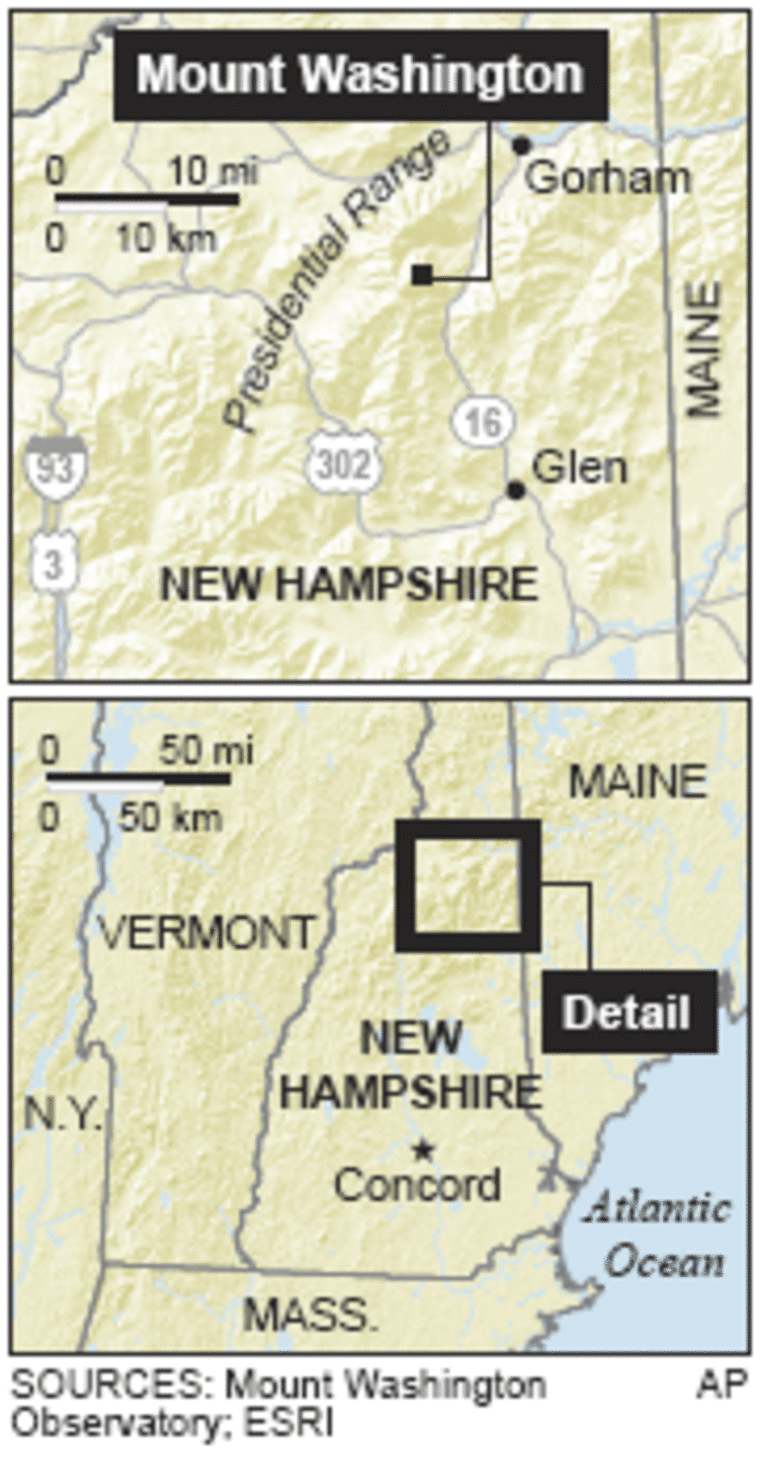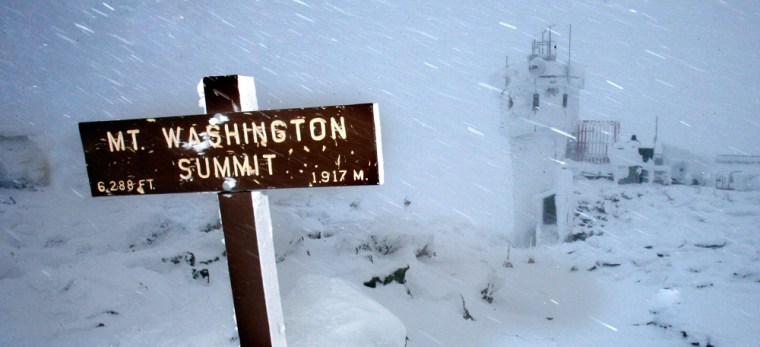First the Old Man, now the Big Wind.
New Hampshire's Mount Washington has lost its distinction as the site of the fastest wind gust ever recorded on Earth, officials at the Mount Washington Observatory conceded on Tuesday.
The concession came three days after the World Meteorological Organization posted a snippet on its Web site saying a panel of experts reviewing extreme weather and climate data turned up a 253 mph gust on Australia's Barrow Island during Cyclone Olivia in 1996.
That tops the 231 mph record set atop Mount Washington on April 12, 1934.
"It's obviously a big disappointment. Having the world record for over six decades was such a part of the soul of this organization and for fans of Mount Washington around the country," said Scot Henley, the observatory's executive director.
The official title at issue is "highest wind gust ever recorded on the surface of the Earth by means of an anemometer." But to most people in New Hampshire, it was simply "the Big Wind," a source of pride in a state that also revered its Old Man of the Mountain, a rock outcropping that appeared to be a man's profile and was featured on the state's quarter.
The Old Man crumbled to bits in 2003, seven years after the wind record apparently toppled.
World's worst weather still claimed
Henley stressed that Mount Washington still holds the record for the Northern and Western hemispheres, and said it still can claim to be home to some of the world's worst weather given the combination of bitter cold, snow, wind and freezing fog it frequently experiences.
"So the work continues up there, and we'll be ready for the next one," he said.
No one noticed the new record gust at the time, Henley said.
"Somehow it fell through the cracks and the Australians didn't think it was a big deal," he said. "We hear that, and it kinds of blows our minds, but of course, we're weather fans and we're tuned into that sort of thing."

Henley first heard about the meteorological organization's conclusion Monday, when someone posted a link to the item on the observatory's forum. He contacted the organization and learned that the information was part of a report being presented at an international conference in Turkey next month.
The panel of experts has shared its research with observatory officials, who plan to review it in the coming weeks.
"There's no reason to believe it's not accurate, but we owe it to this institution and to our state and really to weather fans all over the world to make sure it is indeed accurate," he said.
The Mount Washington Observatory is a private, non-profit organization that maintains a weather station at the summit.
Mary Stampone, assistant professor of geography at the University of New Hampshire and the New Hampshire State Climatologist, said she had long expected the record to fall.
"As we improve our technology in terms of instrumentation, and we're observing in more locations, we were bound to pick up on something," she said.
1934 'war attack' in words
At 6,288 feet, Mount Washington is only one-third the size of Mount McKinley, North America’s highest peak. But Mount Washington sticks up like a big toe at a point where storms from the north, south and west collide. As a result, it can see snow and ice even in the summer.
On April 12, 1934, there were three crew members, two guests, three cats and five kittens at the observatory, according to observer Alex McKenzie, who later wrote a book about the Big Wind.
According to his account, April 12 started with a brilliant sunrise, but the weather soon turned cloudy. By evening, fog obscured the summit and rime ice formed up to a foot thick. Early the next morning, when observer Wendell Stephenson headed outside to clear ice from the anemometer, the wind knocked him flat on his back as he opened the door. When he accidentally dropped the club he was using to break up the ice, it went flying off into the fog. Gusts were at 150 mph.
"I dropped all other activities and concentrated on observations. Everyone in the house was 'mobilized' as during a war attack and assigned a job," observer Sal Pagliuca wrote in a log book.
Gusts grew stronger through the afternoon, until 1:21 p.m., when the 231 mph gust was recorded.
"Many people have wanted to know what we did after that," McKenzie wrote. "Did we cheer or open a bottle of champagne, or what? Well, we didn't do anything special for a while, except make more measurements."
'Signal Service' started monitoring
Observers began recording the weather atop Mount Washington 139 years ago, when the U.S. Signal Service, the military precursor to the National Weather Service, set up shop at the peak, long before winter woolens gave way to Gore-Tex. The building where the men worked still stands, with thick chains buckling it to the mountain rock.
Nicholas Howe wrote about one storm in January 1877 in the book “Not Without Peril.” Winds of 150 mph knocked out windows and lifted a carpet a foot off the floor. Fearful of being swept away, the men “wrapped themselves in blankets and quilts secured with ropes and then they tied on iron crowbars lengthwise as further strengthening against the long fall that seemed inevitable.”
The Signal Service’s tenure on the peak ended in 1892. Forty years later, volunteers revived the observatory, setting up quarters in an old stage coach building.
The nonprofit observatory is the heir to that project. They young staff members are paid little and work 12-hour shifts, seven days a week, performing hourly outdoor observations and maintaining equipment.
The observers get free food, long vacations, every other week off, and when conditions are right, the longest ski run in the Northeast at their feet. They also are minor media stars. Their daily radio forecasts, broadcast in New Hampshire and Maine, are known for their quirky, monotone delivery.
